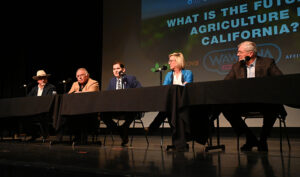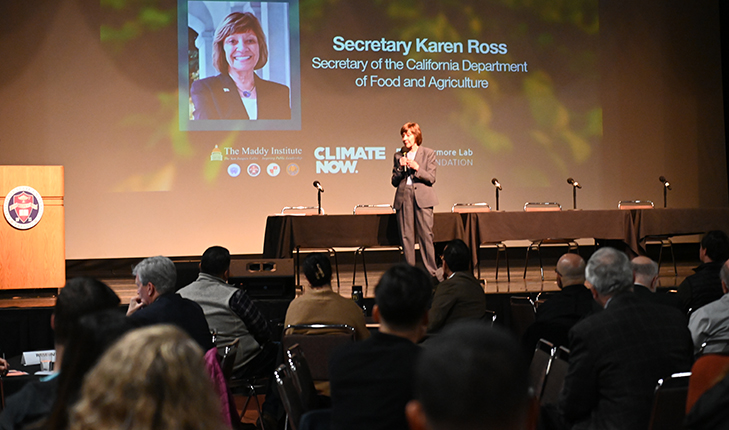California is an innovator with the tools, people and partnerships to achieve net neutrality, but the ability to react nimbly in emergencies is vital.

Panelists, from left: Joe Del Bosque, Del Bosque Farms; Dennis Parnagian, Fowler Packing Company; Fresno State President Saul Jimenez-Sandoval; Sarah Woolf, Water Wise; Bill Smittcamp, Wawona Frozen Foods.
California agriculture is the envy of the world. Despite challenges, the pandemic and other disruptors, farmers and ranchers are innovators and can be part of the climate solution. That was the theme of the keynote message from Karen Ross, California Secretary of Food and Agriculture, at the “What’s the Future of Agriculture” symposium, held March 30 at Fresno State’s Satellite Student Union.
But just as important, especially to local producers, is the need for increased flexibility and adaptability on the part of the state.
More than 700 individuals registered to attend the free, one-day in-person and virtual summit. Presented by The Maddy Institute, in partnership with Fresno State, CSU Bakersfield, Stanislaus State, UC Merced, the Livermore Lab Foundation and Climate Now, this inaugural summit offered an opportunity for key agricultural stakeholders to discuss not only California’s 2045 net-neutrality deadline but specific challenges often related to water, pricing, subsidies and policies.
Steve Blumenshine, the interim executive director of Water Advocacy Toward Education and Research with California State University, talked about the significance of bringing experts, panelists and attendees together at Fresno State.
“There are so many water interests and stakeholders in California. There wouldn’t be any point in convening just CSU, UC or within a specific government agency. Everyone brings a different set of perspectives, values and currencies and deserves to be heard and represented in these conversations.”
In a lunchtime panel on agricultural policy, Fresno State President Saúl Jiménez-Sandoval called on the state to value agriculture as highly as Southern California’s movie industry and Silicon Valley’s tech industries.
Bill Smittcamp, president and CEO of Wawona Frozen Foods, emphasized the need for flexibility and adaptability at the state level.
“In agriculture, we can plan. We can forecast. But it’s never the same year to year,” Smittcamp said. “When things change, we have immediate needs, and we need to be able to change on a dime.”
Joe Del Bosque, owner of Del Bosque Farms said, “Government is failing to react nimbly. We need new measures and new protocols.”
Ross highlighted state policies and grant opportunities available to the agriculture community, but she made it clear the state’s goal was a partnership to achieve results.
“There are 69,000 farms in California, 70% of which are under 100 acres,” she said. “We want to partner with our farmers and ranchers to achieve results and not just rely on the regulatory process. There is a place for regulation, but when it comes to restoration, habitat, and biodiversity, working directly with farmers and ranchers, environmental conservation and restoration groups is where we want to be.”
Farmer and producer panels throughout the day also addressed the Sustainable Groundwater Management Act (SGMA), passed by California in 2014.
“In the long-term, SGMA is the right thing to do,” said Dennis Parnagian owner, Fowler Packing Company. “But it’s challenging to get there.”
Lawrence Livermore National Laboratory Senior Staff Scientist Jennifer Pett-Ridge, an accomplished soil expert, provided the overall technical context for the event by identifying local and national opportunities for sustainable and productive farming.
As a Department of Energy national laboratory, LLNL has placed climate resiliency as a core science and research pillar. In 2020, Livermore issued the comprehensive report, Getting to Neutral, which identified pathways California could take to reach net neutrality by 2045 – including natural land, biomass, direct air capture and geological storage solutions.
“Soils are at the nexus of carbon and energy, water and food security,” Pett-Ridge said. “We’re focusing on sustainable production systems, incentives, just outcomes and the scientific rigor to ensure climate benefits are measurable. Lawrence Livermore National Lab wants to provide the tools and data to shape state and national climate action plans.”
Throughout the day, specific panel discussions were led by each of the four universities including:
- Fresno State’s California Water Institute led a panel on “Enhancing and Preserving Water in the Central Valley,” with a discussion of the Sustainable Groundwater Management Act and how California might develop a water trading market.
- Stanislaus State presented a panel on revenue growth opportunities for landowners facing fallowing land, including what land repurposing looks like in the Central Valley and how it can be done equitably.
- CSU Bakersfield led a panel on “The Business and Economics of Agriculture,” and how climate is impacting agriculture supply chains and business strategies.
- UC Merced presented a panel on its experimental “Smart Farm” featuring data-collection technologies, renewable energy microgrids and sustainability options.





